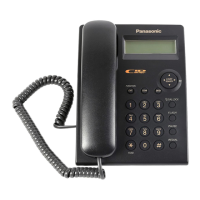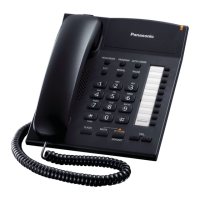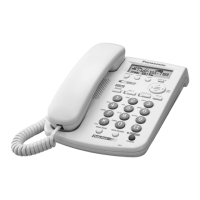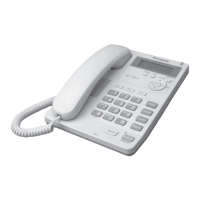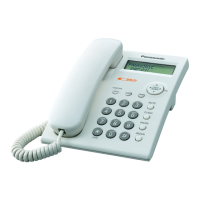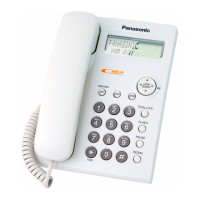The transmitting signal from the H/S or SP-phone is input to CPI (the expander is used to reduce
a noise generated by the transmission system, a cross talk of line transmission, pulse sound, or
ring signal, etc.) and then output from CPO after compression according to the signal level.
The audio signal compressed by the compander is amplified by Q701 and input to VMI for FM
modulation/demodulation and output VTO after the FM modulation. At this time, the regulation of
transmitting frequency is made by X702 or X703.
The XA is switched by Internal depending on whether the set is a master unit or a slave unit. The
switching signal is controlled by Q1 (Master: H, Slave: L).
The output frequency of 15 is 370 kHz (by X703) when a master unit is used or to 410 kHz (by
X702) when a
Slave unit is used.
The FM-modulated audio signal switches on and off the signal output from OE. The transmission
signal is not sent to the line until an intercom transmission starts. This is controlled by Q2 (H:
Voice transmission, L: Prohibition of transmission).
The transmission signal from VTO passes the amplifier mixed with the data signal and then is
transmitted to the telephone line via the transformer (T701).
2) Voice Reception
The data that is transmitted to the telephone line from another set is input via T701 in reverse
order of the transmission.
This signal passes BPF to separate the user’s transmission signal from another set’s signal and
to extract the audio signal of another’s set. If the user’s set is a master unit, the BPF702 (BPF703)
is selected since the carried signal of 410 kHz (370 kHz) is sent from another set.
The receiving signal from another set is input to SIN (MIN) of IC701 to execute FM demodulation.
The demodulated audio signal is output from VAO and input to EXI of the expander for expansion
in contrast with the voice transmission. This signal is output from EOI as the audio signal and
becomes the receiving voice to H/S or SP-phone circuit.
12.9. Calling Line Identification Circuit (Caller ID)
Function:
The caller ID is a chargeable ID which the user of a telephone circuit obtains by entering a
contract with the telephone company to utilize a caller ID service. For this reason, the operation
of this circuit assumes that a caller ID service contract has been entered for the circuit being
used.
The Caller-ID data from exchange is supplied to the telephone using either method of FSK. The
method is chosen according to the exchange of telephone office. This unit is available to receive
the data with both methods and displays the received data on LCD.
- FSK (Frequency Shift Keying) format
51

